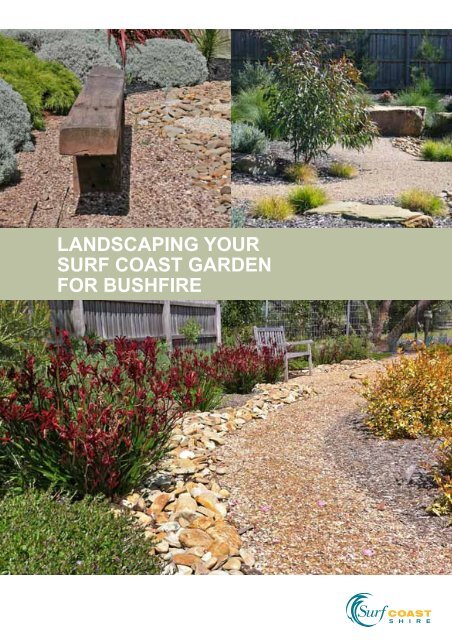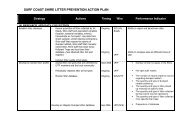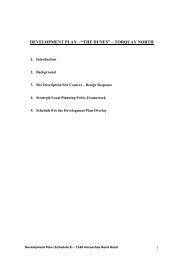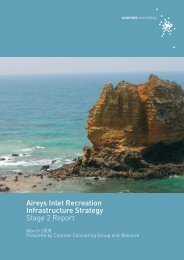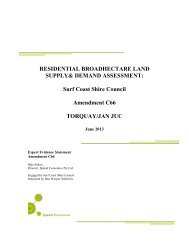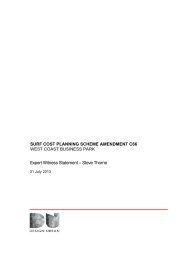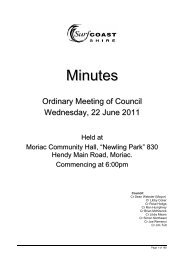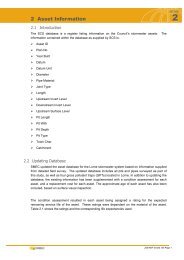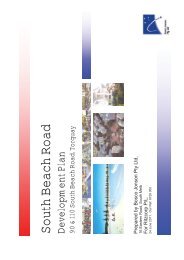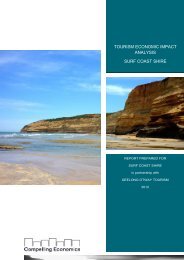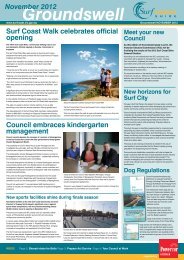Landscaping your surf coast garden for Bushfire - Surf Coast Shire
Landscaping your surf coast garden for Bushfire - Surf Coast Shire
Landscaping your surf coast garden for Bushfire - Surf Coast Shire
You also want an ePaper? Increase the reach of your titles
YUMPU automatically turns print PDFs into web optimized ePapers that Google loves.
<strong>Landscaping</strong> <strong>your</strong><br />
<strong>Surf</strong> <strong>Coast</strong> Garden<br />
<strong>for</strong> <strong>Bushfire</strong>
This booklet has been developed by <strong>Surf</strong> <strong>Coast</strong> <strong>Shire</strong> with funding provided by<br />
the Office of the Emergency Services Commissioner.<br />
<strong>Surf</strong> <strong>Coast</strong> <strong>Shire</strong> makes the in<strong>for</strong>mation contained within this booklet available on<br />
the understanding that you take reasonable care when using it. If you have any<br />
uncertainty about applying the in<strong>for</strong>mation to <strong>your</strong> particular circumstances, you<br />
should seek professional advice.<br />
<strong>Surf</strong> <strong>Coast</strong> <strong>Shire</strong> does not accept responsibility <strong>for</strong> how you apply or rely on the<br />
in<strong>for</strong>mation in this booklet.<br />
Published November 2012
Contents<br />
About this booklet 1<br />
Reducing Victoria’s bushfire risk – an overview 2<br />
Legislating to reduce bushfire risk 3<br />
<strong>Landscaping</strong> to reduce bushfire risk 4<br />
<strong>Bushfire</strong> risk in <strong>Surf</strong> <strong>Coast</strong> <strong>Shire</strong> 5<br />
<strong>Bushfire</strong> risk and the <strong>Surf</strong> <strong>Coast</strong> Planning Scheme 5<br />
Reducing fuel loads through Weeds to Mulch 6<br />
Garden design principles and landscaping actions 7<br />
Action 1: Create planted and non-planted areas 9<br />
Action 2: Consider neighbouring properties. Create<br />
defendable space<br />
Action 3: Keep all combustibles at least 2-3 metres away<br />
from the house<br />
Action 4: Keep vegetation and other flammable plant<br />
materials away from the house<br />
Action 5: Remove environmental weeds 17<br />
Action 6: Plant and maintain non-connecting clusters of<br />
vegetation<br />
Action 7: Plant new trees apart so tree canopies do not<br />
touch<br />
Action 8: Use plants with desirable characteristics 22<br />
Plants with desirable characteristics 23<br />
Garden styles <strong>for</strong> high fire risk areas 30<br />
Bush <strong>garden</strong> 32<br />
Family <strong>garden</strong> 34<br />
Productive <strong>garden</strong> 36<br />
Park <strong>garden</strong> 38<br />
Useful resources 40<br />
Definitions 41<br />
11<br />
13<br />
15<br />
19<br />
21
About this booklet<br />
With its bushfire history, <strong>Surf</strong> <strong>Coast</strong> <strong>Shire</strong> is widely recognised<br />
as one of Victoria’s most bushfire prone areas. As a local<br />
property owner, you have an important role to play in reducing<br />
bushfire risk by the way you design, develop and maintain <strong>your</strong><br />
property.<br />
This booklet aims to help you fulfil this role. It has been<br />
developed specifically <strong>for</strong> <strong>Surf</strong> <strong>Coast</strong> property owners to<br />
complement the CFA’s publication <strong>Landscaping</strong> For <strong>Bushfire</strong>:<br />
Garden Design and Plant Selection.<br />
As such, it seeks to apply the CFA’s four key <strong>garden</strong> design<br />
principles to our local environment and to explain what they<br />
mean <strong>for</strong> you by providing a series of simple actions <strong>for</strong><br />
landscaping on the <strong>Surf</strong> <strong>Coast</strong>.<br />
Four local <strong>garden</strong> styles – each accompanied by a sample<br />
landscape plan – are also included to show how you can use<br />
the actions to create and maintain <strong>your</strong> <strong>garden</strong> to reduce<br />
bushfire risk.<br />
It is recommended that you refer to this booklet as a<br />
companion publication to the CFA’s guide, which provides<br />
more comprehensive in<strong>for</strong>mation about landscaping <strong>for</strong><br />
bushfire across different Victorian environments.<br />
Who should use this booklet<br />
The in<strong>for</strong>mation contained in this booklet is primarily intended<br />
to help local property owners who are:<br />
• in the process of developing new <strong>garden</strong>s or modifying<br />
established <strong>garden</strong>s<br />
• preparing landscaping plans as part of planning permit<br />
requirements, and/or<br />
• involved in the <strong>Shire</strong>’s Weeds to Mulch program (see<br />
page 6).<br />
It may also serve as a useful reference <strong>for</strong>:<br />
• landscape architects<br />
• <strong>Surf</strong> <strong>Coast</strong> <strong>Shire</strong> employees, and<br />
• other individuals, businesses and agencies involved in<br />
vegetation management and/or landscape design in<br />
high fire risk communities.<br />
Use this booklet,<br />
together with the<br />
CFA’s <strong>Landscaping</strong><br />
For <strong>Bushfire</strong>,<br />
to guide you in<br />
developing and<br />
maintaining <strong>your</strong><br />
<strong>garden</strong> to reduce<br />
bushfire risk. Go<br />
to cfa.vic.gov.au<br />
or call 5240 2700 to<br />
obtain a copy of the<br />
CFA publication.<br />
Designing <strong>your</strong> <strong>Surf</strong> <strong>Coast</strong> Garden to Reduce <strong>Bushfire</strong> Risk<br />
1
Reducing Victoria’s bushfire risk<br />
– an overview<br />
Being fire ready<br />
involves more than<br />
just a well-planned<br />
and maintained<br />
property. Go to<br />
cfa.vic.gov.au to<br />
learn about what<br />
else you can do to<br />
be more fire ready<br />
and remember on<br />
Severe, Extreme<br />
and Code Red<br />
days, leaving early<br />
will always be the<br />
safest option.<br />
Be<strong>for</strong>e summer each year, Victorians are reminded of the<br />
need to develop their bushfire plans, prepare themselves and<br />
their properties, and remain vigilant throughout the fire danger<br />
period. The CFA is responsible <strong>for</strong> declaring the fire danger<br />
period, which generally runs in <strong>Surf</strong> <strong>Coast</strong> <strong>Shire</strong> between mid<br />
to late December and early April.<br />
At the individual property level, reducing bushfire risk involves:<br />
• understanding how fire behaves in <strong>your</strong> local<br />
environment; and<br />
• knowing the steps to take to prepare <strong>your</strong> home and<br />
property by developing <strong>your</strong> <strong>Bushfire</strong> Survival Plan.<br />
The CFA website (cfa.vic.gov.au) contains a wealth of<br />
in<strong>for</strong>mation and resources to help you become fire ready<br />
including:<br />
• everything you need to prepare <strong>your</strong> <strong>Bushfire</strong> Survival<br />
Plan<br />
• the complete Fire Ready Kit<br />
• online tools to assess and understand <strong>your</strong> level of<br />
bushfire risk<br />
• how to prepare <strong>your</strong> home and property to be fire ready<br />
• how to design and maintain <strong>your</strong> <strong>garden</strong> to reduce<br />
bushfire risk, and<br />
• back up plans.<br />
In addition, the CFA provides a range of community bushfire<br />
safety in<strong>for</strong>mation and advice programs such as:<br />
• Fire Ready Victoria meetings and bushfire planning<br />
workshops, which cover how to prepare a <strong>Bushfire</strong><br />
Survival Plan<br />
• Free Home <strong>Bushfire</strong> Advice Service, where Fire Safety<br />
Officers visit <strong>your</strong> home to assess and provide advice<br />
regarding <strong>your</strong> bushfire risk<br />
• Community Fireguard to help you and <strong>your</strong> neighbours<br />
prepare <strong>for</strong> bushfire<br />
• Victorian <strong>Bushfire</strong> In<strong>for</strong>mation Line and Fire Ready<br />
Smart Phone App, and<br />
• online bushfire in<strong>for</strong>mation sessions.<br />
2<br />
You can access more in<strong>for</strong>mation about all these programs and<br />
other CFA resources – including <strong>Landscaping</strong> For <strong>Bushfire</strong> (the<br />
companion publication to this booklet) – at the CFA website.
Legislating to reduce bushfire risk<br />
In November 2011, the Victorian Government introduced<br />
permanent planning controls as part of implementing the<br />
recommendations of the 2009 Victorian <strong>Bushfire</strong>s Royal<br />
Commission.<br />
The changes include new exemptions from the requirement <strong>for</strong><br />
a planning permit to remove native vegetation to help reduce<br />
fuel loads around existing homes.<br />
In summary, the two main exemptions, which apply only to<br />
existing dwellings built or approved be<strong>for</strong>e 10 September<br />
2009, are the:<br />
• 10/30 rule where property owners do not need a<br />
planning permit to clear:<br />
1. Any vegetation, including trees, within 10 metres of<br />
their house, or<br />
2. Any vegetation, except <strong>for</strong> trees, within 30 metres of<br />
their house.<br />
• 10/50 rule, which applies only to properties within a<br />
<strong>Bushfire</strong> Management Overlay (see page 5). Under this<br />
rule property owners within a <strong>Bushfire</strong> Management<br />
Overlay do not need a planning permit to clear:<br />
1. Any vegetation, including trees, within 10 metres of<br />
their house or<br />
2. Any vegetation, except <strong>for</strong> trees, within 50 metres of<br />
their house.<br />
If <strong>your</strong> property is not covered by either of these exemptions,<br />
you may require a planning permit to remove native vegetation<br />
on <strong>your</strong> property. Note that if you do not meet planning permit<br />
requirements, you may be subject to financial penalties.<br />
If you’re building a new home, the planning permit process<br />
already includes consideration of clearing <strong>for</strong> bushfire<br />
protection.<br />
For more in<strong>for</strong>mation about planning permit requirements<br />
<strong>for</strong> native vegetation removal, please contact the <strong>Surf</strong> <strong>Coast</strong><br />
<strong>Shire</strong>’s Planning Enquiries Officer (Ph. 5261 0600).<br />
Refer to the <strong>Surf</strong><br />
<strong>Coast</strong> Planning<br />
Scheme, which sets<br />
out the regulations <strong>for</strong><br />
clearing vegetation<br />
on private properties<br />
across the <strong>Shire</strong>,<br />
including instances<br />
where a planning<br />
permit is not required.<br />
Go to the My Property<br />
section at www.<br />
<strong>surf</strong><strong>coast</strong>.vic.gov.<br />
au or contact the<br />
Planning Department<br />
(Ph. 5261 0600).<br />
Designing <strong>your</strong> <strong>Surf</strong> <strong>Coast</strong> Garden to Reduce <strong>Bushfire</strong> Risk<br />
3
<strong>Landscaping</strong> to reduce bushfire risk<br />
Many of the<br />
publications listed<br />
in the Useful<br />
Resources section<br />
of this booklet<br />
contain more<br />
in<strong>for</strong>mation about<br />
bushfire behaviour<br />
and landscape<br />
design. The <strong>Shire</strong>’s<br />
Fire Safety and<br />
Environment Officer<br />
also provides on-site<br />
advice to help local<br />
property owners<br />
in high fire risk<br />
areas. This includes<br />
in<strong>for</strong>mation about<br />
bushfire behaviour<br />
and how to reduce<br />
the level of risk<br />
through appropriate<br />
landscaping.<br />
In simple terms, fire behaviour – and its effect on homes<br />
– is influenced by weather, fuel (i.e. vegetation and other<br />
combustible materials) and topography (i.e. slope).<br />
Appropriate landscaping – incorporating good design<br />
principles and plant selection, location and arrangement –<br />
can help to minimise a bushfire’s major destructive <strong>for</strong>ces (i.e.<br />
ember attack, radiant heat, direct flame contact and wind) and<br />
increase the likelihood of <strong>your</strong> home surviving.<br />
<strong>Landscaping</strong> <strong>for</strong> bushfire involves:<br />
• assessing the property, its layout, surrounds and<br />
existing vegetation, which includes considering<br />
prevailing weather conditions and local planning<br />
requirements<br />
• designing <strong>your</strong> <strong>garden</strong> in line with planning requirements<br />
and the principles/actions that relate to reducing<br />
bushfire risk<br />
• establishing and modifying the <strong>garden</strong> as needed, and<br />
• maintaining it over time.<br />
As illustrated by the photos throughout this booklet,<br />
landscaping elements may be hard (e.g. gravel, pavers, walls)<br />
or soft (e.g. plants, trees, <strong>garden</strong> beds) with the ideal <strong>garden</strong><br />
featuring a combination of both.<br />
<strong>Bushfire</strong> is complex and dynamic. It is beyond the scope of this<br />
booklet to present landscape designs that address the specific<br />
site characteristics of <strong>your</strong> property (e.g. aspect, topography,<br />
vegetation) and predicted bushfire behaviour.<br />
The following paragraph, taken from the 2009 Victorian<br />
<strong>Bushfire</strong>s Royal Commission Final Report, provides a general<br />
overview of fire behaviour in Victoria:<br />
“In Victoria, hot dry winds often come from the north and<br />
northwest, and are often followed by a southwest wind<br />
change. Wind speed and direction is one of four weather<br />
elements affecting the spread of a fire, and wind change<br />
is a common feature of bushfire disasters in Victoria. A<br />
change in wind direction usually turns the flank of a fire into<br />
a fire front several kilometres wide.”<br />
4
<strong>Bushfire</strong> risk in <strong>Surf</strong> <strong>Coast</strong> <strong>Shire</strong><br />
The CFA has identified the following <strong>Surf</strong> <strong>Coast</strong> <strong>Shire</strong><br />
townships as being high fire risk:<br />
• Aireys Inlet (including Fairhaven, Moggs Creek and<br />
Eastern View)<br />
• Anglesea<br />
• Bambra<br />
• Jan Juc/Bellbrae<br />
• Lorne (including Big Hill), and<br />
• Deans Marsh.<br />
Each of these townships has a Community In<strong>for</strong>mation<br />
Guide in place, which includes:<br />
• in<strong>for</strong>mation about local bushfire risk, and<br />
• general advice on how to reduce bushfire risk and<br />
prepare <strong>for</strong> and respond to bushfires.<br />
The guides can be downloaded from the CFA website (cfa.vic.<br />
gov.au/firesafety/bushfire/help/index.htm).<br />
<strong>Bushfire</strong> risk and the <strong>Surf</strong> <strong>Coast</strong> Planning Scheme<br />
The <strong>Surf</strong> <strong>Coast</strong> Planning Scheme identifies high fire risk areas<br />
across the municipality and applies the <strong>Bushfire</strong> Management<br />
Overlay to these areas.<br />
This overlay is a planning control that seeks to address<br />
the level of bushfire risk by implementing specific bushfire<br />
protection measures, primarily to areas where there is potential<br />
<strong>for</strong> extreme bushfire behaviour due to significant fuel loads<br />
(i.e. vegetation). In addition to vegetation, it takes into account<br />
prevailing weather characteristics and topographical factors.<br />
Properties in high fire risk areas may also be affected by other<br />
overlay controls, such as those relating to the protection of<br />
significant landscapes or native flora and fauna.<br />
Understanding how to implement the various controls can be<br />
difficult sometimes, particularly when their intentions appear to<br />
conflict (e.g. fuel reduction versus retaining vegetation).<br />
A planning permit<br />
is not required to<br />
remove weeds. <strong>Surf</strong><br />
<strong>Coast</strong> <strong>Shire</strong> provides<br />
a range of in<strong>for</strong>mation<br />
to help you identify<br />
and control weeds on<br />
<strong>your</strong> property. Go to<br />
www.<strong>surf</strong><strong>coast</strong>.vic.<br />
gov.au/environment<br />
/publications<br />
to access this<br />
in<strong>for</strong>mation or call<br />
5261 0600.<br />
Designing <strong>your</strong> <strong>Surf</strong> <strong>Coast</strong> Garden to Reduce <strong>Bushfire</strong> Risk<br />
5
To find out more<br />
about the Weeds<br />
to Mulch program<br />
contact the <strong>Shire</strong>’s<br />
Community<br />
Fire Safety and<br />
Environment<br />
Officer<br />
(Ph. 5261 0600).<br />
To find out the overlay controls that apply to <strong>your</strong> property,<br />
including the <strong>Bushfire</strong> Management Overlay, and how to<br />
implement them appropriately you can:<br />
• contact the <strong>Shire</strong>’s Planning Enquiries Officer<br />
(Ph. 5261 0600), or<br />
• access this in<strong>for</strong>mation via dpcd.vic.gov.au/<br />
planningschemes or Planning Maps Online at the Land<br />
Channel (land.vic.gov.au).<br />
Reducing fuel loads through Weeds to Mulch<br />
The <strong>Surf</strong> <strong>Coast</strong> <strong>Shire</strong>’s Weeds to Mulch program targets fuel<br />
reduction on private land located in the bush/urban interface<br />
areas of several high fire risk townships, including Anglesea,<br />
Aireys Inlet, Fairhaven and Moggs Creek.<br />
In currently focusing on private land, the program supports the<br />
strategic township and asset protection objectives of the <strong>Surf</strong><br />
<strong>Coast</strong> <strong>Shire</strong> Municipal Fire Protection Plan.<br />
Since its implementation in 2005, participating property owners<br />
have helped to remove close to 1,000 cubic metres of weeds.<br />
At the same time, this has left some participants wondering<br />
about what to plant to replace the weeds that have been<br />
removed, and where and how any new plants should be<br />
located. Consequently, demand <strong>for</strong> local in<strong>for</strong>mation about<br />
appropriate landscaping and vegetation management has<br />
increased.<br />
This booklet aims to provide this in<strong>for</strong>mation at a general level.<br />
The principles and actions on the following pages focus on<br />
creating ‘defendable space’ around <strong>your</strong> home by modifying<br />
vegetation and other landscaping elements to reduce direct<br />
flame contact and radiant heat. For new homes, defendable<br />
space is calculated as part of the planning permit process; <strong>for</strong><br />
existing homes, it can be calculated using the CFA’s online<br />
House <strong>Bushfire</strong> Self-Assessment Tool.<br />
6
Garden design principles<br />
and landscaping actions<br />
In landscaping <strong>your</strong> <strong>garden</strong> to reduce bushfire risk, consider<br />
using at least one of the following design principles and<br />
associated actions, which can affect bushfire behaviour.<br />
Whether you choose to apply one, some or all will be<br />
dependent on <strong>your</strong> specific circumstances, including level<br />
of risk and <strong>Bushfire</strong> Survival Plan. Refer to pages 8 to 22 <strong>for</strong><br />
more in<strong>for</strong>mation about each of the actions.<br />
CFA Design Principle 1<br />
1. Create<br />
defendable space<br />
2. Remove<br />
flammable objects<br />
from around the<br />
3. Break up fuel<br />
continuity<br />
4. Carefully select,<br />
locate and maintain<br />
trees<br />
<br />
house<br />
<br />
<strong>Landscaping</strong> Action 2<br />
Action 1: Create<br />
planted and nonplanted<br />
areas<br />
Action 2: Consider<br />
neighbouring<br />
properties. Create<br />
defendable space<br />
Action 3: Keep all<br />
combustibles at<br />
least 2-3 metres<br />
away from the<br />
house<br />
Action 4: Keep<br />
vegetation and<br />
other flammable<br />
plant materials<br />
away from the<br />
house<br />
Action 5: Remove<br />
environmental<br />
weeds<br />
Action 6: Plant<br />
and maintain nonconnecting<br />
clusters<br />
of vegetation<br />
Action 7: Plant<br />
new trees apart so<br />
canopies do not<br />
touch<br />
Action 8:<br />
Use plants<br />
with desirable<br />
characteristics<br />
<br />
Likely Effect/s on <strong>Bushfire</strong> Behaviour<br />
Reduces fuel<br />
loads, eliminates<br />
direct flame contact<br />
and minimises<br />
radiant heat<br />
Minimises<br />
opportunities <strong>for</strong><br />
direct flame contact<br />
on <strong>your</strong> house<br />
Reduces<br />
opportunities <strong>for</strong><br />
fire to spread<br />
from the <strong>garden</strong><br />
to <strong>your</strong> house and<br />
between structures<br />
and neighbouring<br />
properties<br />
Can help to reduce<br />
wind speed, absorb<br />
radiant heat and<br />
filter embers<br />
Note 1 – For more detail about each Design Principle, refer to <strong>Landscaping</strong> <strong>for</strong> <strong>Bushfire</strong> (CFA, 2011).<br />
Note 2 – Refer to the next section <strong>for</strong> more in<strong>for</strong>mation about each action.<br />
Designing <strong>your</strong> <strong>Surf</strong> <strong>Coast</strong> Garden to Reduce <strong>Bushfire</strong> Risk<br />
7
✓<br />
This outdoor dining area helps to prevent direct flame<br />
contact by providing separation between house and <strong>garden</strong>.<br />
✓<br />
Paved entertaining areas and other hard landscaping<br />
features help to break up vegetation.<br />
✓<br />
Non-flammable pathways can be used to separate <strong>garden</strong><br />
beds to break up fuel continuity.<br />
8
Action 1:<br />
Create planted and non-planted areas<br />
Designing <strong>your</strong> <strong>garden</strong> to include both planted and nonplanted<br />
areas helps to create defendable space by breaking<br />
up fuel continuity across the site and minimising the ‘ladder’<br />
fuel effect (where fuel carries fire from the ground into the tree<br />
canopy).<br />
Planted areas should be arranged in non-connecting clusters<br />
with non-planted areas (e.g. gravel, lawns, driveways,<br />
entertaining/play areas) used to separate them. This can help<br />
to prevent direct flame contact and minimise the impacts of<br />
radiant heat on <strong>your</strong> house.<br />
Other things to consider include:<br />
• mulching with a variety of materials, particularly nonflammables<br />
(e.g. gravel, pebbles, shells, crushed<br />
bricks)<br />
• choosing and arranging plant types to minimise the<br />
‘ladder’ effect<br />
• using appropriate landscaping features (e.g. stone<br />
walls) to create barriers to wind, radiant heat and<br />
embers, and<br />
• managing existing vegetation appropriately, including<br />
by removing loose bark, leaf litter and fine fuels.<br />
In a bushfire, plants<br />
can provide a<br />
continual fuel path<br />
to the house and<br />
act as ‘ladder’ fuel<br />
from the ground<br />
into tree canopies –<br />
both major factors<br />
contributing to<br />
bushfire behaviour,<br />
which can lead<br />
to house loss.<br />
Selecting,<br />
locating and<br />
arranging plants<br />
appropriately helps<br />
to reduce this risk.<br />
✗<br />
Planting grasses, shrubs and trees together, and/or<br />
building piles of wood and other flammable materials,<br />
creates ‘ladder’ fuel, which carries fire from the ground up<br />
into the tree canopy.<br />
Designing <strong>your</strong> <strong>Surf</strong> <strong>Coast</strong> Garden to Reduce <strong>Bushfire</strong> Risk<br />
9
✓<br />
Addressing vegetation continuity across <strong>your</strong> property,<br />
including between neighbouring properties, can help to<br />
decrease a bushfire’s speed and intensity.<br />
✗<br />
Plants running right up to the house can carry fire directly<br />
into <strong>your</strong> home and put <strong>your</strong> neighbours’ homes at risk.<br />
Vines and creepers can also carry fire from the ground<br />
into the tree canopy, which increases the risk to <strong>your</strong> own<br />
and neighbouring properties.<br />
✗<br />
10<br />
Using combustible materials <strong>for</strong> boundary fences and<br />
screens exposes you and <strong>your</strong> neighbours to greater risk<br />
of property loss in a bushfire.
Action 2:<br />
Consider neighbouring properties<br />
Create defendable space<br />
The way you design and landscape <strong>your</strong> property can<br />
significantly affect the level of bushfire risk <strong>for</strong> neighbouring<br />
properties – and vice versa.<br />
Continuity of vegetation between properties and the location of<br />
other combustible materials (e.g. wooden fences and screens)<br />
in relation to neighbouring households can compromise<br />
defendable space by increasing the potential <strong>for</strong> fire to spread<br />
quickly from one property to another.<br />
Look at how you can use <strong>your</strong> property boundary to reduce<br />
bushfire risk including by:<br />
• reducing fuel loads along the boundary by removing<br />
weeds and managing vegetation (e.g. mowing/slashing<br />
grass, pruning shrubs, lopping trees, removing plant<br />
debris)<br />
• appropriate plant selection, location and maintenance<br />
according to the actions in this booklet and the CFA’s<br />
principles, and<br />
• using appropriate landscaping features (e.g. nonconnecting<br />
<strong>garden</strong> beds, paths, driveways, fences,<br />
screens) to create space and/or barriers between <strong>your</strong><br />
home and neighbouring properties.<br />
The Weeds to Mulch program focuses on removing woody<br />
environmental weeds, including along boundaries and from the<br />
road verge/nature strip. This may result in loss of screening.<br />
If screening is to be reinstated inside the property boundary,<br />
please refer to this booklet to select, locate, arrange and<br />
maintain appropriate screening materials.<br />
Focus on reducing<br />
the potential <strong>for</strong><br />
fire to spread to<br />
<strong>your</strong> property<br />
from neighbouring<br />
households – and<br />
vice versa – and<br />
design and maintain<br />
<strong>your</strong> <strong>garden</strong><br />
accordingly.<br />
Designing <strong>your</strong> <strong>Surf</strong> <strong>Coast</strong> Garden to Reduce <strong>Bushfire</strong> Risk<br />
11
✓<br />
Artwork such as mosaics<br />
and sculptures made from<br />
non-flammable materials<br />
are ideal landscaping<br />
features that can<br />
contribute to reducing <strong>your</strong><br />
home’s bushfire risk.<br />
Metal screens can<br />
help to shield <strong>your</strong><br />
house from radiant<br />
heat, direct flame<br />
contact and ember<br />
attack.<br />
✓<br />
Use non-flammable<br />
gravel and rock <strong>for</strong><br />
paving and mulching<br />
inside the two to<br />
three-metre perimeter<br />
around <strong>your</strong> home.<br />
✓<br />
12
Action 3:<br />
Keep all combustibles at least 2-3 metres<br />
away from the house<br />
Combustible materials, plant and non-plant, close to the house<br />
compromise defendable space by increasing the potential <strong>for</strong><br />
localised direct flame contact.<br />
Keeping them at a safe distance (two to three metres as the<br />
minimum) away from the building – particularly vulnerable<br />
components such as windows, doors, decks, pergolas and<br />
eaves – increases <strong>your</strong> home’s chances of surviving a<br />
bushfire.<br />
Some suggestions to help you achieve this include:<br />
• locating non-flammable materials (e.g. stones, rocks,<br />
gravel, sand, paving) and features (e.g. screens, walls,<br />
sculptures, mosaics constructed using non-combustible<br />
materials) within the two to three-metre perimeter<br />
immediately around the house.<br />
• moving flammable structures and objects (e.g. caravans,<br />
outdoor furniture, barbecues, gas bottles, wood piles,<br />
plant-based mulches) well away from this two to threemetre<br />
perimeter during predicted Severe, Extreme and<br />
Code Red days<br />
• using non-combustible planters and pots, and relocating<br />
these outside the immediate perimeter during summer<br />
• planting trees and shrubs outside the perimeter and<br />
ensuring they don’t encroach inside this area by<br />
removing overhanging branches and leaf litter, and<br />
• using non-flammable mulching materials.<br />
The area<br />
immediately<br />
surrounding <strong>your</strong><br />
home should be kept<br />
free of all flammable<br />
objects – which<br />
can easily ignite<br />
during a bushfire<br />
– to increase the<br />
likelihood of <strong>your</strong><br />
home surviving.<br />
✓<br />
Metal screening provides privacy and beauty, and can act as a barrier<br />
against a bushfire’s destructive <strong>for</strong>ces. Combustible materials such as<br />
outdoor furniture should be moved away from the home’s immediate<br />
perimeter on Severe, Extreme and Code Red days.<br />
Designing <strong>your</strong> <strong>Surf</strong> <strong>Coast</strong> Garden to Reduce <strong>Bushfire</strong> Risk<br />
13
✗<br />
Trees and shrubs abutting the home increase the<br />
effects of direct flame contact and radiant heat.<br />
✗<br />
Look at overhanging branches and leaf litter as fuel<br />
sources that can lead to major property loss during a<br />
bushfire – and manage them appropriately as part of<br />
<strong>your</strong> <strong>Bushfire</strong> Survival Plan.<br />
✓<br />
14<br />
Use of suitable ground and low level plants, nonflammable<br />
mulching and stone features (e.g. pathways<br />
and walls) helps to keep the perimeter around the<br />
home free of flammable materials.
Action 4:<br />
Keep vegetation and other flammable plant materials<br />
away from the house<br />
As fuel sources in a bushfire, vegetation and other flammable<br />
plant materials (e.g. leaf litter, debris) cause fire to spread<br />
increasing the potential <strong>for</strong> ember attack and direct flame<br />
contact. They there<strong>for</strong>e need to be managed appropriately,<br />
particularly in the perimeter around the house, to ensure<br />
defendable space is maintained.<br />
This does not necessarily mean clearing all plants and trees.<br />
Depending on its flammability, location and management<br />
regime, existing vegetation may be suitable to be retained.<br />
Refer to the actions pertaining to plant location and<br />
arrangement, and to the Plants with desirable characteristics<br />
section in this booklet. The Plant Selection Key at cfa.vic.<br />
gov.au or in <strong>Landscaping</strong> For <strong>Bushfire</strong> also provides a useful<br />
guide.<br />
Other actions include:<br />
• locating trees at least 1.5 times their mature height<br />
away from the house (e.g. mature height 8 metres x<br />
1.5 = 12 metres)<br />
• regularly removing leaf litter, particularly from areas<br />
where it tends to accumulate (e.g. house corners,<br />
doors, windows, gutters, some rooflines, decks), and<br />
• keeping grass to no more than five centimetres high<br />
around the immediate perimeter and 10 centimetres<br />
or less elsewhere.<br />
Trees should be<br />
located well away<br />
from the house<br />
to minimise the<br />
potential <strong>for</strong> radiant<br />
heat and direct<br />
flame contact<br />
via overhanging<br />
branches and falling<br />
limbs and trunks.<br />
Designing <strong>your</strong> <strong>Surf</strong> <strong>Coast</strong> Garden to Reduce <strong>Bushfire</strong> Risk<br />
15
✗<br />
Woody weeds such as pine trees should be removed as<br />
they contribute significantly to fuel loads.<br />
✗<br />
As major fuel sources woody weeds and other noxious<br />
plants can increase a bushfire’s intensity and speed.<br />
16
Action 5:<br />
Remove environmental weeds<br />
Environmental weeds are both woody and non-woody,<br />
and may be declared noxious under State legislation. In<br />
<strong>Surf</strong> <strong>Coast</strong> <strong>Shire</strong>, environmental weeds include trees and<br />
shrubs (e.g. Pines, <strong>Coast</strong> Tea-tree, Boneseed, Cape Broom,<br />
Pittosporum, <strong>Coast</strong> Wattle), herbs and succulents (e.g.<br />
Agapanthus, Gazania, Blanket Weed), and grasses and<br />
rushes (e.g. Serrated Tusock, Pampas).<br />
In a bushfire, woody environmental weeds provide a major<br />
fuel source, which contributes to the speed and intensity at<br />
which fire spreads. Removing these weeds, and ensuring<br />
other vegetation is located and arranged appropriately,<br />
can help to break up fuel continuity and substantially reduce<br />
opportunities <strong>for</strong> fire to spread.<br />
The <strong>Surf</strong> <strong>Coast</strong> <strong>Shire</strong>’s Weeds to Mulch program focuses on<br />
removing woody environmental weeds from private land to<br />
reduce fuel loads around high fire risk townships, including<br />
Anglesea and Aireys Inlet. Contact the Community Fire<br />
Safety and Environment Officer (Ph. 5261 0600) to find<br />
out more about this program, or <strong>for</strong> advice about removing<br />
weeds from <strong>your</strong> property and selecting, locating and<br />
arranging replacement plants to reduce bushfire risk.<br />
Woody environmental<br />
weeds represent<br />
a major bushfire<br />
threat because they<br />
tend to invade and<br />
occupy more ‘middle<br />
storey’ space than<br />
local indigenous<br />
species. In a bushfire,<br />
this influences<br />
fire behaviour by<br />
increasing the<br />
intensity and speed at<br />
which fire spreads.<br />
The <strong>Shire</strong>’s website (www.<strong>surf</strong><strong>coast</strong>.vic.gov.au) also<br />
includes in<strong>for</strong>mation about weeds along with local planting<br />
guides, which can help you to choose local indigenous plant<br />
species that may contribute to reducing bushfire risk.<br />
✓<br />
Replacing environmental<br />
weeds with local indigenous<br />
plant species and landscaping<br />
features such as gravel pathways<br />
contributes to defendable space<br />
around the home.<br />
Designing <strong>your</strong> <strong>Surf</strong> <strong>Coast</strong> Garden to Reduce <strong>Bushfire</strong> Risk<br />
17
✓<br />
Arranging suitable plants into non-connecting clusters, separated by<br />
non-flammable mulching materials (e.g. sand, gravel) breaks up fuel<br />
continuity.<br />
✓<br />
<strong>Landscaping</strong> features such as rocks can be used within and<br />
between clusters to separate plants.<br />
18
Action 6:<br />
Plant and maintain non-connecting<br />
clusters of vegetation<br />
Fuel continuity makes it easy <strong>for</strong> fire to spread across <strong>your</strong><br />
property up to the house and to neighbouring properties. By<br />
separating plants, <strong>garden</strong> beds and tree canopies however,<br />
you effectively break up fuel continuity and reduce or prevent<br />
the path of fuel to the house.<br />
Use the concept of non-connecting clusters of vegetation as<br />
the basis <strong>for</strong> designing and building <strong>your</strong> <strong>garden</strong> to reduce<br />
bushfire risk. This includes:<br />
• arranging plants and <strong>garden</strong> beds into defined areas<br />
separated by no or low fuel features (e.g. paths, lawns,<br />
pavers, walls)<br />
• ensuring shrubs and other flammable materials are<br />
located away from trees to reduce the ‘ladder’ fuel<br />
effect, and<br />
• preventing a continuous canopy by creating discrete<br />
clusters of shrubs and trees separated by no/low fuel<br />
areas.<br />
Fire spreads easily<br />
when plants are located<br />
close together with<br />
the availability of a<br />
continuous fuel path<br />
making it easier <strong>for</strong> fire<br />
to destroy <strong>your</strong> home<br />
through direct flame<br />
contact and radiant heat.<br />
Designing <strong>your</strong> <strong>Surf</strong> <strong>Coast</strong> Garden to Reduce <strong>Bushfire</strong> Risk<br />
19
✓<br />
Some tree species, such as these Southern Blue Gums,<br />
are protected under local planning controls but still require<br />
careful management to reduce bushfire risk.<br />
✓<br />
Groundcover, shrubs and other ‘middle storey’ plants need to be<br />
selected and arranged appropriately in relation to canopy trees to<br />
ensure they don’t provide ‘ladder’ fuel in a bushfire.<br />
20
Action 7:<br />
Plant new trees apart so tree canopies do not touch<br />
A continuous tree canopy compromises defendable space<br />
by contributing to a bushfire’s intensity and speed. If located<br />
too close to the house, it significantly increases <strong>your</strong> home’s<br />
exposure to radiant heat and direct flame contact via falling<br />
trees and tree limbs.<br />
To prevent a continuous tree canopy:<br />
• space trees apart to create breaks of at least two metres<br />
between canopies<br />
• locate trees at least 1.5 times their mature height away<br />
from the house and other buildings and structures (e.g.<br />
power lines, water tanks) – allow even more space <strong>for</strong><br />
tall mature trees with large canopies<br />
• separate the canopy from ground level fuel by pruning<br />
the branches to a minimum of two metres above the<br />
ground, and<br />
• do not plant shrubs and other flammable plants and<br />
materials directly under trees as they can carry fire into<br />
the canopy via the ‘ladder’ fuel effect.<br />
Keep the area immediately<br />
under the tree canopy clear of<br />
shrubs, leaf litter, plant debris<br />
(e.g. bark, twigs, branches)<br />
and other flammable materials.<br />
According to the CFA, fire is<br />
rarely sustained in the tree<br />
canopy unless there is a fire<br />
burning in the plants or leaf<br />
litter under the tree.<br />
Designing <strong>your</strong> <strong>Surf</strong> <strong>Coast</strong> Garden to Reduce <strong>Bushfire</strong> Risk<br />
21
Action 8:<br />
The <strong>Surf</strong><br />
<strong>Coast</strong> <strong>Shire</strong><br />
website (www.<br />
<strong>surf</strong><strong>coast</strong>.vic.<br />
gov.au) features<br />
photos and<br />
in<strong>for</strong>mation about<br />
local native plants<br />
– many of which<br />
possess desirable<br />
characteristics.<br />
There is also a<br />
section devoted<br />
to weeds.<br />
Use plants with desirable characteristics<br />
Plant selection, arrangement and location can contribute<br />
to reducing the risk of losing <strong>your</strong> home in a bushfire. Plants<br />
should be selected according to their flammability as a<br />
contributing factor to bushfire behaviour. Where and how they<br />
are located and arranged are critical to reducing bushfire risk<br />
as indicated by many of the actions in this booklet.<br />
In general, when selecting plants to reduce bushfire risk<br />
choose plants that:<br />
• are easily maintained by pruning or mowing<br />
• require little water<br />
• do not lose large amounts of leaves or needles<br />
• have thick, fleshy leaves or stems<br />
• display leaves with an open transparent branching<br />
pattern, and<br />
• have a high moisture content (i.e. succulent).<br />
Plants that are considered to have good characteristics <strong>for</strong><br />
planting in high fire risk areas include: succulents, rushes,<br />
sedges, small shrubs with low foliage density, and eucalypts<br />
with easily removable loose bark or non stringybark. Ongoing<br />
maintenance is essential as many of these plants may become<br />
more susceptible to bushfire if not maintained properly.<br />
Non-desirable plant species of particular note include:<br />
Cypress, Conifers, Pines and Paperbark.<br />
Refer to the next section in this booklet and the Plant Selection<br />
Key at cfa.vic.gov.au or in <strong>Landscaping</strong> For <strong>Bushfire</strong>, and<br />
choose plants that possess desirable characteristics along<br />
with low to moderate flammability. The following pages feature<br />
some of these plants.<br />
22
Plants with desirable characteristics<br />
This section provides a small sample of just some of the plants, many indigenous<br />
to the <strong>Surf</strong> <strong>Coast</strong>, with good characteristics <strong>for</strong> planting in high fire risk areas. They<br />
have been assessed against the CFA’s Plant Selection Key and rated as moderate<br />
to low flammability. Note that all plants, regardless of flammability ratings, require<br />
regular and ongoing maintenance to address anticipated bushfire behaviour.<br />
As indicated by the diagram on page 27, a good cross-section of plant heights is<br />
shown – from climbers and scramblers, groundcover and low level plants to medium<br />
level and tall.<br />
For more in<strong>for</strong>mation, contact <strong>Surf</strong> <strong>Coast</strong> <strong>Shire</strong>’s Community Safety and<br />
Environment Unit (Ph. 5261 0600). Many local community groups can also advise<br />
on local indigenous plant species and weeds. The CFA’s Plant Selection Key in<br />
<strong>Landscaping</strong> For <strong>Bushfire</strong> provides a useful tool <strong>for</strong> assessing plant flammability to<br />
assist in selecting plants with desirable characteristics.<br />
Climbers and<br />
scramblers<br />
<strong>Coast</strong> Twin Leaf<br />
(Zygophyllum billardierei)<br />
Ground<br />
(less than 5cms)<br />
Karkalla<br />
(Carpobrotus rossii)<br />
Ruby Saltbush<br />
(Enchylaena tomentosa)<br />
<strong>Coast</strong> Bonefruit<br />
(Threlkeldia diffusa)<br />
Designing <strong>your</strong> <strong>Surf</strong> <strong>Coast</strong> Garden to Reduce <strong>Bushfire</strong> Risk<br />
23
Low (less than 1m in height)<br />
Long Purple Flag<br />
(Patersonia occidentalis)<br />
Spiny-headed Mat-rush<br />
(Lomandra longifolia)<br />
Variable Sword-sedge<br />
(Lepidosperma laterale var. laterale)<br />
Knobby Club-sedge<br />
(Ficinia nodosa)<br />
Common Raspwort<br />
(Gonocarpus tetragynus)<br />
Common Everlasting<br />
(Chrysocephalum apiculatum)<br />
Small-Fruit Fan-flower<br />
(Scaevola albida)<br />
Thin-leaf Wattle<br />
(Acacia aculeatissima)<br />
24
Low<br />
Ploughshare Wattle<br />
(Acacia gunnii)<br />
Sea-box<br />
(Alyxia buxifolia)<br />
Blunt Everlasting<br />
(Argentipallium obtusifolium)<br />
Grass Daisy<br />
((Brachyscome graminea)<br />
Designing <strong>your</strong> <strong>Surf</strong> <strong>Coast</strong> Garden to Reduce <strong>Bushfire</strong> Risk<br />
25
Medium<br />
(1m to 3m)<br />
Sweet Wattle<br />
(Acacia suaveolens)<br />
Austral Indigo<br />
(Indigofera australis))<br />
Green Correa<br />
(Correa aff. reflexa)<br />
Sticky Boobialla<br />
(Myoporum petiolatum)<br />
Dusty Miller<br />
(Spyridium parvifolium)<br />
Gold-dust Wattle<br />
(Acacia acinacea)<br />
26
Medium<br />
Spreading Wattle<br />
(Acacia genistifolia)<br />
tall > 3m<br />
Myrtle Wattle<br />
(Acacia myrtifolia)<br />
canopy<br />
medium 1m- 3m<br />
low < 1m<br />
ground < 5cm<br />
Designing <strong>your</strong> <strong>Surf</strong> <strong>Coast</strong> Garden to Reduce <strong>Bushfire</strong> Risk<br />
27
Tall<br />
(shrubs and trees more than 3m)<br />
Red Ironbark<br />
(Eucalyptus tricarpa)<br />
Garden Wattle<br />
(Acacia pycnantha)<br />
Narrow-leaf Wattle<br />
(Acacia mucronata subsp. longifolia)<br />
Mountain Grey Gum<br />
(Eucalyptus cypellocarpa)<br />
Blackwood<br />
(Acacia melanoxylon)<br />
Blue Gum<br />
(Eucalyptus globulus subsp. globulus)<br />
28
Tall<br />
Scent-bark<br />
(Eucalyptus aromaphloia)<br />
Manna Gum<br />
(Eucalyptus viminalis subsp. viminalis)<br />
Swamp Gum<br />
(Eucalyptus ovata)<br />
Shining Peppermint<br />
(Eucalyptus falci<strong>for</strong>mis)<br />
Narrow-leaved Peppermint<br />
(Eucalyptus radiata)<br />
Hazel Pomaderris<br />
(Pomaderris aspera)<br />
Designing <strong>your</strong> <strong>Surf</strong> <strong>Coast</strong> Garden to Reduce <strong>Bushfire</strong> Risk<br />
29
Garden styles <strong>for</strong> high fire risk areas<br />
When establishing a new <strong>garden</strong> or modifying an existing one,<br />
choosing a style can help you to achieve a space that suits<br />
<strong>your</strong> needs. Applying the principles and actions outlined in this<br />
booklet to <strong>your</strong> preferred style also contributes to reducing<br />
bushfire risk in high fire risk areas.<br />
The four <strong>garden</strong> styles appearing on the following pages<br />
have been developed to suit <strong>Surf</strong> <strong>Coast</strong> conditions. They are<br />
intended to provide a guide and actions to landscaping <strong>your</strong><br />
<strong>garden</strong> to reduce bushfire risk.<br />
Using one style, or combination of each, may help<br />
you determine lay-out, plant selection, location and<br />
arrangement, landscaping features, access and overall<br />
usability, including ongoing maintenance.<br />
Each style is accompanied by a sample landscape plan that<br />
illustrates how the bushfire <strong>garden</strong> design principles and<br />
actions can be applied to that particular style.<br />
These plans are intended to be generic. As such, they do not<br />
indicate the attributes of adjoining properties or the nature<br />
strip/road verge. It is recommended that you review <strong>your</strong><br />
landscaping annually, with respect to the design guidelines<br />
in this booklet and adjoining land, as part of <strong>your</strong> <strong>Bushfire</strong><br />
Survival Plan.<br />
This <strong>garden</strong> style<br />
uses a paved area as<br />
an attractive <strong>garden</strong><br />
feature that provides<br />
separation between<br />
the home and planted<br />
areas to create<br />
defendable space in a<br />
bushfire.<br />
30
The CFA’s <strong>Landscaping</strong> For <strong>Bushfire</strong> provides a series of<br />
<strong>garden</strong> design styles <strong>for</strong> generic settings (e.g. <strong>coast</strong>, hills,<br />
rural, suburban), which offer additional in<strong>for</strong>mation related to<br />
designing <strong>your</strong> <strong>garden</strong> to reduce bushfire risk.<br />
The following steps may be helpful when it comes to planning<br />
<strong>your</strong> fire ready <strong>garden</strong>, including choosing a <strong>garden</strong> style – or<br />
combination of styles – that meets <strong>your</strong> needs.<br />
1. Develop an understanding of how <strong>your</strong> <strong>garden</strong> is or<br />
will be used by considering issues such as: access<br />
and movement of people (e.g. pathways, gates);<br />
location of productive patches, outdoor dining/<br />
relaxation and play areas, adjoining properties,<br />
<strong>garden</strong> sheds and storage, firewood, water tanks,<br />
clothes lines and the like; and conserving existing<br />
native vegetation.<br />
2. Make a sketch map of the site showing location of<br />
pathways, access points and other key features,<br />
including existing native vegetation and trees.<br />
Identify any environmental weeds to be removed.<br />
3. Assess the areas available <strong>for</strong> planting/<br />
revegetation.<br />
4. Choose a range of local indigenous species in<br />
consideration of the overall <strong>garden</strong> style and which<br />
have low to moderate flammability as per the CFA<br />
Plant Selection Key.<br />
5. Locate and arrange the plants and mulching materials<br />
according to the actions outlined on pages 7 to 22.<br />
This includes considering the arrangement of ground<br />
plants, and small and tall shrubs and trees, to<br />
minimise the ‘ladder’ fuel effect.<br />
6. Consider non-combustible landscape features <strong>for</strong><br />
screening, walls, sculptures and the like.<br />
7. Consider contacting landscape architects and/or<br />
landscape contractors <strong>for</strong> assistance and advice.<br />
Whatever <strong>garden</strong> style or combination you choose to go with,<br />
focus on minimising opportunities <strong>for</strong> direct flame contact and<br />
radiant heat by planting vegetation in non-connecting clusters,<br />
using species of low to moderate flammability, arranged in a<br />
manner that does not favour the ‘ladder’ fuel effect.<br />
Whatever style<br />
you choose as<br />
the basis <strong>for</strong><br />
designing <strong>your</strong><br />
<strong>garden</strong>, focus on<br />
creating a <strong>garden</strong><br />
you and <strong>your</strong><br />
family can enjoy<br />
while contributing<br />
to reducing <strong>your</strong><br />
property’s bushfire<br />
risk.<br />
Designing <strong>your</strong> <strong>Surf</strong> <strong>Coast</strong> Garden to Reduce <strong>Bushfire</strong> Risk<br />
31
The bush <strong>garden</strong><br />
can present a<br />
high bushfire risk<br />
due to the type<br />
and arrangement<br />
of vegetation.<br />
Regular, intensive<br />
maintenance is<br />
essential during the<br />
fire danger period.<br />
Bush <strong>garden</strong><br />
The bush <strong>garden</strong> style is characterised by a natural setting<br />
featuring native bushland – including local indigenous plants<br />
that support native wildlife – and little <strong>for</strong>mality and apparent<br />
structure.<br />
Whether it encompasses the entire site, or focuses on<br />
retaining or establishing discrete stands of native bushland<br />
in appropriate locations with respect to the home and other<br />
structures, plant selection and arrangement are critical to<br />
the level of bushfire risk.<br />
The area’s history (e.g. fire, clearing) and the presence<br />
of predominant native vegetation communities (e.g.<br />
heathland, woodland, <strong>for</strong>est, tall <strong>for</strong>est) need to be taken into<br />
consideration.<br />
Choose appropriate local indigenous species <strong>for</strong> biodiversity<br />
and adaptation to local conditions, and maintain spaces<br />
between vegetation clusters to reduce connectivity and<br />
minimise fire spread.<br />
Natural hard landscaping materials and features (e.g. rock and<br />
stone sculptures, walls, benches, seats, paving) complement<br />
this style and provide separation between vegetation and<br />
the home to reduce the risk of direct flame contact during a<br />
bushfire.<br />
Although this <strong>garden</strong> style generally requires minimal attention<br />
throughout the year, regular maintenance is critical during the<br />
fire danger period to keep leaf litter and fine fuels (i.e. less<br />
than 6mm diameter) to a minimum. Continued monitoring and<br />
removal of weeds, particularly woody weeds, is essential.<br />
Rock walls and other hard<br />
landscaping features can be<br />
used in the bush <strong>garden</strong> to<br />
break up vegetation clusters and<br />
reduce fire spread.<br />
Retaining low fuel areas between<br />
stands of native vegetation also<br />
reduces fire spread.<br />
32
<strong>Bushfire</strong> <strong>garden</strong> design guidelines applied<br />
to the Bush Garden
Family <strong>garden</strong><br />
The family <strong>garden</strong><br />
style can add to<br />
bushfire risk if<br />
flammable plants,<br />
elements and<br />
materials feature in<br />
the perimeter around<br />
the home. Ensure<br />
they are kept a safe<br />
distance away and<br />
pay attention to leaf<br />
litter, plant debris<br />
and other fine fuels,<br />
which must be<br />
regularly cleared<br />
during the fire<br />
danger period.<br />
The family <strong>garden</strong> style focuses on creating an environment<br />
that nurtures children’s play and imagination while providing<br />
areas <strong>for</strong> adult relaxation and entertaining.<br />
Key components generally include:<br />
• a combination of spaces <strong>for</strong> enjoyment and function<br />
• minimal, low-key vegetation with an emphasis on<br />
safety and visual appeal<br />
• children’s play equipment<br />
• outdoor furniture<br />
• safety fencing, and<br />
• grassed areas.<br />
As well as addressing bushfire risk, plant selection <strong>for</strong> the<br />
family <strong>garden</strong> should consider children’s safety and allergy<br />
concerns. Some plants can cause hay fever or skin irritations<br />
while others contain toxic elements (e.g. castor oil plant,<br />
oleander, arum lily, some bulbs, flax lily, rhubarb). ‘Soft’ plants<br />
(i.e. no hard spines) are also safest around children.<br />
In terms of using this style to reduce bushfire risk, locating<br />
entertainment and play areas (constructed using nonflammable<br />
materials), low fuel areas (e.g. lawn) and other<br />
landscaping features (e.g. paths, fences, screens) in the<br />
perimeter around the home will separate it from planted areas<br />
and contribute to defendable space.<br />
The family <strong>garden</strong>, like all <strong>garden</strong> styles, generally requires<br />
regular upkeep (e.g. mowing, pruning, weeding) throughout<br />
the year and more intensive maintenance during the fire<br />
danger period to keep leaf litter and fine fuels to a minimum,<br />
particularly in vulnerable areas around the home (e.g. roof<br />
gutters, windows, decks, doors, corners).<br />
In the family <strong>garden</strong>, lawns,<br />
entertainment and play areas<br />
close to the house provide<br />
enjoyment while reducing<br />
opportunities <strong>for</strong> direct flame<br />
contact.<br />
34
<strong>Bushfire</strong> <strong>garden</strong> design guidelines applied<br />
to the Family Garden
Remember to<br />
incorporate the<br />
bushfire <strong>garden</strong><br />
design guidelines<br />
and actions in<br />
designing <strong>your</strong><br />
productive <strong>garden</strong>.<br />
Ongoing care and<br />
maintenance all<br />
year round are vital<br />
to a successful<br />
productive <strong>garden</strong><br />
that also contributes<br />
to reducing bushfire<br />
risk.<br />
Productive <strong>garden</strong><br />
Of the four <strong>garden</strong> styles outlined in this booklet, the<br />
productive <strong>garden</strong> requires the most planning, ongoing care<br />
and maintenance due to its focus on growing and using plants<br />
<strong>for</strong> food and other purposes.<br />
In terms of designing a productive <strong>garden</strong> to reduce bushfire<br />
risk, the same guidelines apply in relation to creating<br />
defendable space around the home. This <strong>garden</strong> style,<br />
which often takes up just a section of the site, can also be<br />
successfully incorporated within the other <strong>garden</strong> styles.<br />
Things to take into account when designing a productive<br />
<strong>garden</strong> include its aspect in relation to the sun, access to<br />
water and proximity to shade (i.e. adjacent vegetation and tree<br />
canopies).<br />
Understanding the movement of sunlight across the site over<br />
the different seasons also determines plant selection (many<br />
productive plants require at least six hours sunlight a day).<br />
Pots can also be useful additions as they can be used all year<br />
round and easily moved to accommodate changes in seasons<br />
and sunlight.<br />
Composting areas, pathways, wind protection and trees<br />
(including fruit trees) should also be considered in using<br />
this style.<br />
The same principles and<br />
actions apply to the location<br />
and arrangement of planted<br />
and non-planted areas in the<br />
productive <strong>garden</strong> as <strong>for</strong> the<br />
other <strong>garden</strong> styles.<br />
36
<strong>Bushfire</strong> <strong>garden</strong> design guidelines applied<br />
to the Productive Garden
A well-designed<br />
and executed<br />
park <strong>garden</strong>,<br />
incorporating the<br />
bushfire <strong>garden</strong><br />
design principles<br />
and actions, can<br />
substantially<br />
decrease bushfire<br />
risk. Selecting,<br />
locating and<br />
maintaining trees<br />
appropriately is the<br />
key factor in using<br />
this style.<br />
Park <strong>garden</strong><br />
The park <strong>garden</strong> style is quite distinctive and generally<br />
consists of a well maintained and manicured ground layer, a<br />
few grasses and groundcovers or shrubs, and a number of<br />
small to large trees featuring interspersed canopies.<br />
This style is characteristic of many reserves and parks across<br />
<strong>Surf</strong> <strong>Coast</strong> <strong>Shire</strong>, and can be seen around the boundaries<br />
of many acreage properties in Aireys Inlet, Lorne and other<br />
bushland townships.<br />
As the eucalypt trees, which are a strong feature of this style,<br />
take many years to mature, the park <strong>garden</strong> can take time to<br />
establish.<br />
Careful selection, location and maintenance of trees is the<br />
key consideration in using the park <strong>garden</strong> style to reduce<br />
bushfire risk. Ensuring tree canopies are well spaced and do<br />
not encroach into the defendable space perimeter around the<br />
home are critical.<br />
The actions pertaining to removing flammable materials away<br />
from the home and breaking up fuel continuity should also be<br />
considered when designing, developing and maintaining a<br />
park style <strong>garden</strong>.<br />
Features of the park <strong>garden</strong> style, such as seating, pathways and manicured<br />
lawns, all contribute to reducing bushfire risk by breaking up fuel continuity to<br />
create defendable space around the home.<br />
Many <strong>Surf</strong> <strong>Coast</strong> reserves feature<br />
the park <strong>garden</strong> style in their design<br />
and can help to provide inspiration <strong>for</strong><br />
designing <strong>your</strong> own park <strong>garden</strong>.<br />
38
<strong>Bushfire</strong> <strong>garden</strong> design guidelines applied<br />
to the Park Garden
Useful resources<br />
Publications<br />
<strong>Surf</strong> <strong>Coast</strong> <strong>Shire</strong><br />
(download from www.<strong>surf</strong><strong>coast</strong>.vic.gov.au or call 5261 0600)<br />
• Weeds of the <strong>Surf</strong> <strong>Coast</strong> <strong>Shire</strong> (2012)<br />
• Municipal Fire Management Plan (2010)<br />
• Rural Indigenous Planting Guide (2003)<br />
• Urban Indigenous Planting Guide (2003)<br />
CFA (download from cfa.vic.gov.au or call 5240 2700)<br />
• Fire Ready Kit (2011)<br />
• <strong>Landscaping</strong> <strong>for</strong> <strong>Bushfire</strong>: Garden Design and Plant Selection (2011)<br />
• Wildfire Management Overlay Applicants Kit (2010)<br />
Other (access via the websites provided)<br />
• Landscape and Building Design <strong>for</strong> <strong>Bushfire</strong> Areas, CSIRO (2003) -<br />
www.csiro.au<br />
• 2009 Victorian <strong>Bushfire</strong>s Royal Commission Final Report, Parliament of<br />
Victoria 2009 Victorian <strong>Bushfire</strong>s Royal Commission (2010) -<br />
www.royalcommission.vic.gov.au<br />
• <strong>Bushfire</strong> Practice and Advisory Notes (about application of the Victorian<br />
Planning Provisions and a range of planning processes and topics relating to<br />
bushfire), Department of Planning and Community Development (2009-2011) -<br />
www.dpcd.vic.gov.au/planning/publicationsandresearch<br />
• <strong>Surf</strong> <strong>Coast</strong> <strong>Shire</strong> Planning Scheme, <strong>Surf</strong> <strong>Coast</strong> <strong>Shire</strong> (2006) -<br />
http://planningschemes.dpcd.vic.gov.au/<br />
Websites<br />
• www.<strong>surf</strong><strong>coast</strong>.vic.gov.au (<strong>Surf</strong> <strong>Coast</strong> <strong>Shire</strong>)<br />
• cfa.vic.gov.au (CFA – Country Fire Authority)<br />
• dpcd.vic.gov.au (Department of Planning and Community Development)<br />
• dse.vic.gov.au (Department of Sustainability and Environment)<br />
• land.vic.gov.au (Land Channel)<br />
• dpi.vic.gov.au (Department of Primary Industries)<br />
• www.csiro.au (CSIRO - Commonwealth Scientific and Industrial Research<br />
Organisation)<br />
Contacts<br />
<strong>Surf</strong> <strong>Coast</strong> <strong>Shire</strong> (Ph. 5261 0600 Email info@<strong>surf</strong><strong>coast</strong>.vic.gov.au)<br />
CFA – Barwon South West Region (Ph. 5240 2700)<br />
A suitably qualified and experienced landscape architect, designer or contractor can<br />
also provide help and advice in relation to landscaping <strong>for</strong> bushfire.<br />
40
Definitions<br />
Canopy is the layer or multiple layers of branches and foliage<br />
at the crown (top) of a tree.<br />
Combustible materials (e.g. timber, firewood) require ignition<br />
from a dominant source to burn.<br />
Flammable materials (e.g. propane gas) are easily ignited<br />
by minimal sources (i.e. they have a lower flashpoint than<br />
combustible materials) and capable of burning rapidly.<br />
All flammable materials are combustible but not all combustible<br />
materials are flammable.<br />
Direct flame contact occurs when flames touch a house or<br />
other structure.<br />
Ember attack occurs when burning fine fuels (e.g. twigs,<br />
leaves, bark) are carried by the wind and land in and around<br />
houses and their <strong>garden</strong>s, often igniting spot fires.<br />
Environmental weeds include:<br />
• noxious plants declared as a problem under Victorian<br />
legislation and requiring landholders to control, and<br />
• woody plants with hard woody parts, especially stems.<br />
Fire danger period is a time during which fires in the open<br />
air are legally restricted due to high fire danger. Under the<br />
Country Fire Authority Act 1958, the CFA is responsible <strong>for</strong><br />
declaring the fire danger period in a municipality. In Victoria,<br />
the fire danger period generally runs from November to April.<br />
Fuel load refers to the amount of vegetation, plant debris, leaf<br />
litter and other flammable materials around a property that is<br />
capable of carrying fire in a bushfire. High fuel loads increase<br />
the speed and intensity at which fire travels.<br />
Ladder fuel is where vegetation is continuous and vertical<br />
between different plant heights and types, allowing fire to carry<br />
from <strong>surf</strong>ace fine fuels (e.g. leaves, twigs) into the crowns of<br />
trees or shrubs.<br />
Planning scheme generally applies to a defined municipal<br />
area such as <strong>Surf</strong> <strong>Coast</strong> <strong>Shire</strong> (and some special planning<br />
areas) and sets out the policies and provisions applying to the<br />
use and development of land in that area.<br />
Designing <strong>your</strong> <strong>Surf</strong> <strong>Coast</strong> Garden to Reduce <strong>Bushfire</strong> Risk<br />
41
Plant height guide:<br />
• ground level/storey – plants less than 50cm in height,<br />
leaf litter, twigs, branches<br />
• low level/storey – plants less than 1m in height,<br />
grasses, sedges, rushes, small shrubs<br />
• medium level or middle storey – plants 1m to 3m in<br />
height, medium shrubs, small trees, and<br />
• tall or upper level/storey – shrubs and trees more than<br />
3m in height.<br />
Radiant heat is capable of igniting <strong>surf</strong>aces without direct<br />
flame contact, cracking/breaking windows, distorting/melting<br />
materials and drying out vegetation ahead of a bushfire so that<br />
it burns more easily.<br />
42
Acknowledgements<br />
<strong>Surf</strong> <strong>Coast</strong> <strong>Shire</strong> acknowledges the CFA <strong>for</strong> its advice and<br />
assistance in developing this booklet. The CFA publication<br />
<strong>Landscaping</strong> For <strong>Bushfire</strong>: Garden Design and Plant Selection<br />
was also referred to extensively during the process of finalising<br />
this booklet’s content.<br />
The four sample landscape designs were prepared by Mexted<br />
Rimmer Landscape Architects.<br />
Additional images provided by Ocean Road <strong>Landscaping</strong>,<br />
Margaret MacDonald and Stuut Artistry and Design.


